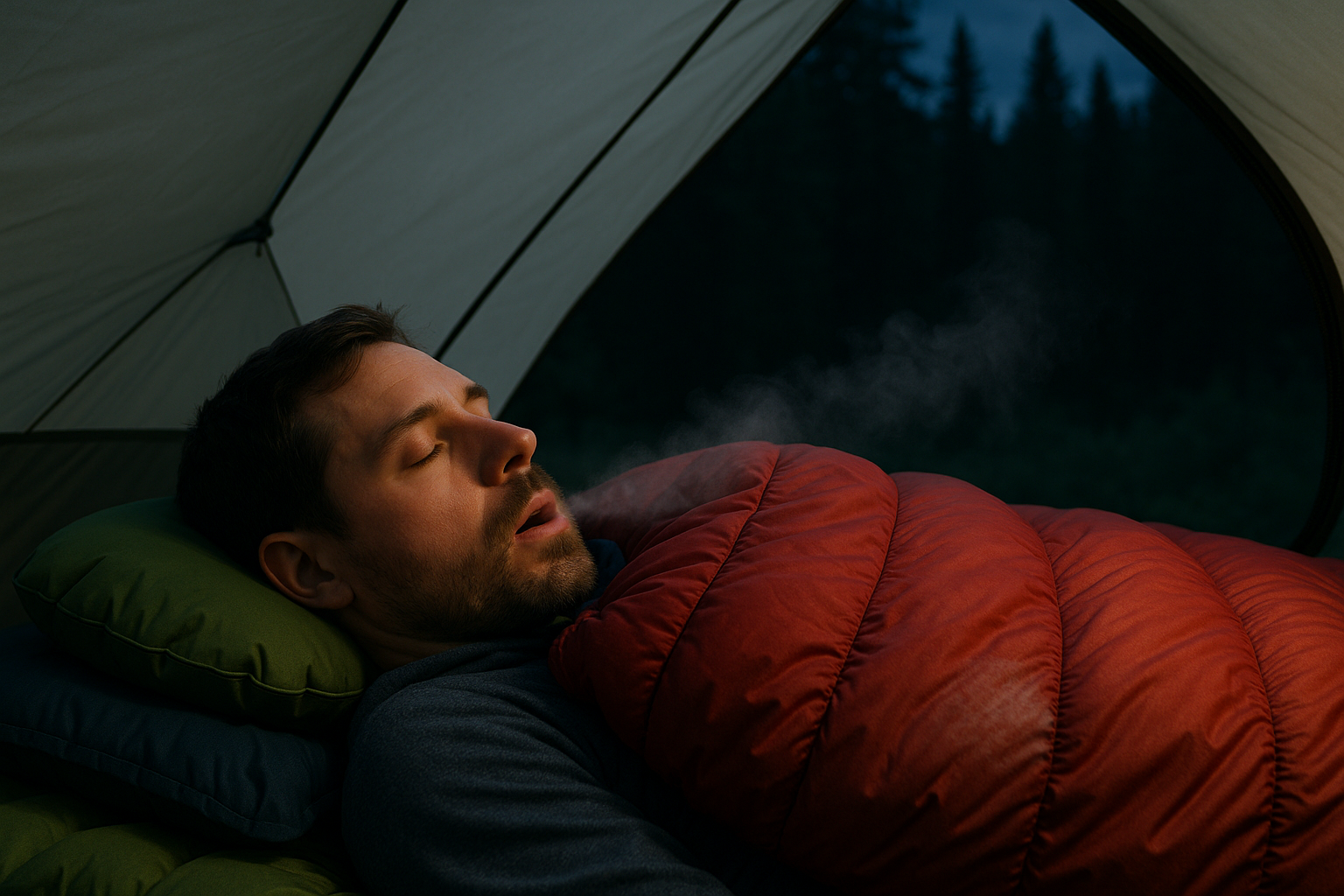Your sleeping bag was rated for 15°F.
You followed all the rules.
But you woke up freezing—and your bag feels flat, clammy, and cold to the touch.
What happened?
It wasn’t your insulation.
It was your breath.
💧 The Real Culprit: Condensation from Nighttime Breathing
Every time you exhale, you release warm, moist air. In a cold tent or bivy, that vapor quickly cools and condenses on:
- Your sleeping bag hood
- The inner tent walls
- Your face and neck
- The inside of your bag, if you’re breathing into it
Over time, that moisture soaks into the insulation, compromising loft—the critical airspace that keeps you warm.
🔥 Once a down or synthetic bag loses loft, it loses all insulation ability.
🚩 Symptoms of Loft Loss from Moisture
- Bag feels clammy or wet near the hood or chest in the morning
- You feel colder each night, even in the same temps
- Bag appears visibly compressed or matted down
- Insulation shifts or clumps together (especially down)
- Your body shivers despite good base layers and bag rating
🎯 The Goal: Stop Moisture From Ever Entering Your Bag
Here’s how to do it—with zero extra weight, and gear you already have (plus a few optional upgrades).
Let’s start with your most effective defense line: your face.
😤 1. Stop Breathing into the Bag: Always Vent Around Your Face
Problem:
It feels cozy to bury your head in your bag when it’s freezing.
But that’s the fastest way to ruin it.
Your breath will:
- Condense inside the bag
- Soak insulation near the hood
- Collapse loft by morning
Solution:
- Use the drawstring collar to cinch around your neck, not your face
- Sleep with your mouth and nose exposed to fresh air
- Direct exhale down and away from the bag—never inside
🧠 Sleeping with your nose out in the cold is counterintuitive—but it’s the only way to preserve bag performance overnight.
🧣 2. Use a Buff or Face Cover as a Moisture Catch
A lightweight buff, balaclava, or breathable scarf can:
- Capture moisture before it hits your bag
- Shield your lips and nose from wind
- Prevent frostbite on exposed skin
Product Tip:
- Smartwool Merino 150 Buff – lightweight, breathable, fast-drying
- Zpacks Ventum Wind Shell Balaclava – ultralight with good airflow
🧠 Rotate face coverings mid-trip if needed to keep moisture away from your sleep system.
🌬️ 3. Improve Tent Ventilation to Let Moisture Escape
You may be creating a humidity trap without realizing it.
Fixes:
- Crack both top and bottom vents of your tent—even just 1 inch
- Sleep with the zipper slightly open (use a mosquito net if needed)
- Avoid breathing directly toward tent walls—angle yourself sideways
💨 Even sub-zero alpine tents should have some air circulation. Moisture without airflow = disaster.
🧪 4. Add a Breath Shield to Your Sleep System
For extreme conditions, consider adding a moisture barrier above your sleeping bag collar:
- Small microfiber towel
- Quick-dry bandana
- DIY triangle of mesh or fleece, clipped to hood drawstring
This traps condensation just inches from your mouth, and it dries quickly in sunlight.
🧠 Never place a plastic bag or non-breathable item near your mouth—condensation will pool and soak everything faster.
🧥 5. Use a VBL (Vapor Barrier Liner) for Multi-Day Trips
If you’re winter camping for more than 2 nights in sub-freezing temps, this may be your ultimate weapon.
What is it?
A vapor barrier liner is a non-breathable layer (usually worn or placed inside your sleeping bag) that traps sweat vapor and exhaled moisture before it hits insulation.
How to Use:
- Wear a VBL shirt and pants set OR
- Insert a VBL sleeping bag liner inside your main bag
Gear Options:
- RBH Designs Vapor Mitts + Shirt + Socks
- Western Mountaineering VBL Liner Bag (4.5 oz)
- DIY VBL: use an emergency bivy sack inside your main bag
Pros:
- Keeps bag completely dry
- Adds warmth (retains your own humidity)
Cons:
- Sweaty if used above ~25°F
- Takes some getting used to
🧠 Expedition climbers swear by VBLs to keep their down bags dry for weeks in alpine conditions.
☀️ 6. Dry Your Bag at First Light—Every Day
Even if you followed every rule above, some moisture will still accumulate.
Do this:
- Unzip your bag fully each morning
- Turn inside out (exposing lining to sun/air)
- Lay it across a rock, tree, or tent in sunlight or wind
- Dry for 15–30 minutes, even on cloudy days
Bonus:
Use a black stuff sack or lay the bag on dark gear—absorbs solar warmth faster.
🧠 Even 5 minutes of sun every morning adds 2–3 nights of usable loft on long trips.
🛠️ 7. Sleeping Bag Shells: Use DWR Wisely (But Know the Limits)
Modern sleeping bags often have a DWR (durable water repellent) outer shell.
This protects against:
- Tent wall drips
- Splashback from wet gear
- Minor dew/frost
But DWR won’t stop moisture from inside the bag—and it slows drying when insulation does get wet.
Recommendation:
- Use DWR sleeping bags or top quilts with caution in humid conditions
- Ventilate often and pair with a liner or breathable shell for best results
🧠 Drying your bag at noon matters more than how waterproof it is at midnight.
🏕️ Bonus: Shelter Setup Affects Condensation
Better:
- Tarp with wind vent
- Double-wall tent with fly spaced off body
- Open bivy with head exposed (use FRH or warmers to supplement)
Worse:
- Single-wall tent with poor airflow
- Enclosed bivy sack without ventilation
- Lean-to shelters in low, windless valleys
Pro Tip:
If you must camp in humid zones, sleep on a slope with cold air drainage—not in a bowl where mist collects.
📋 Summary Table: Sleeping Bag Moisture Fixes
| Problem | Fix |
|---|---|
| Bag soaked from breath | Sleep with face out, use buff or breath shield |
| Condensation in tent | Vent high and low, open fly, avoid sealed tents |
| Multi-day loft loss | Use VBL or dry in sun each day |
| Damp chest zone | Stuff microfiber barrier in collar |
| Clammy mornings | Flip and fluff bag every sunrise |
🌄 Final Words: Don’t Let Your Bag Die in the Dark
Your sleeping bag is your last line of defense in cold camping.
And once moisture steals its loft, it’s just a soggy blanket in a nylon coffin.
You don’t need more gear—you need smarter strategy.
Breathe smart. Vent early. Dry often.
And your bag will keep you warm when it matters most.

